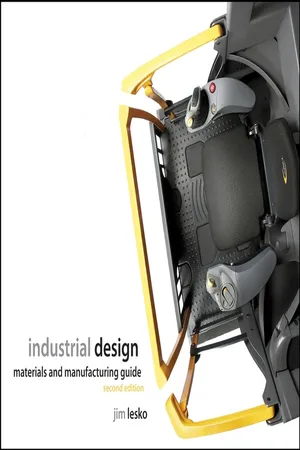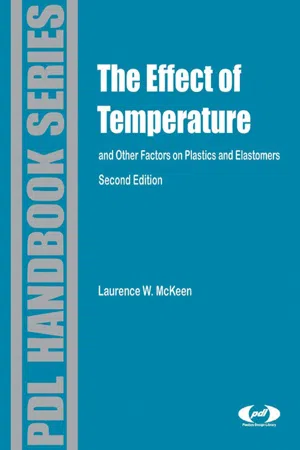Elastomers
Elastomers are polymers with elastic properties, allowing them to return to their original shape after being stretched or compressed. They are widely used in various engineering applications due to their ability to provide flexibility, resilience, and durability. Common examples of elastomers include rubber, silicone, and polyurethane, and they are utilized in products such as tires, seals, and gaskets.
7 Key excerpts on "Elastomers"
- Nicholas P. Cheremisinoff, Paul N. Cheremisinoff(Authors)
- 2020(Publication Date)
- CRC Press(Publisher)
...4 Dynamic Viscoelastic Properties of Polymeric Materials Shoichiro Yano and Takeshi Kitano National Institute of Materials and Chemical Research, Tsukuba, Ibaraki, Japan I. INTRODUCTION Polymeric materials are used in a wide variety of industries, including aircraft, automobile, building and construction, electronics, furniture, packaging, and consumer products. They have replaced traditional materials, such as metals, ceramics, and wood, because of the advantages in their mechanical properties, their low density, processability, chemical resistance, and low cost. Polymers have flexible chains with high molecular weights of more than 10,000, thus giving the polymer a characteristic transition temperature, T g and an interesting property called viscoelasticity. This viscoelasticity indicates the mechanical properties of both an elastic solid and viscous liquid. The mechanical properties of a polymer change with temperature, as listed in Table 1. Below T g, a polymer is in a glassy state and has an elastic modulus of about 5 GPa. In the transition region at around T g, the polymer is in a leathery state and the modulus changes rapidly from about 5 GPa to 2–5 MPa. Above T g, there is a region called the rubbery plateau region where the polymer has a constant modulus of around 1–0.1 MPa and is rubberlike. At temperatures higher than those in the rubbery plateau region, the modulus of the polymer decreases to 10 5 -10 4 Pa, and polymer begins to flow; this is the rubbery flow region. At temperatures much higher than those in the rubbery flow region, the modulus drops down below 10 4 Pa, and the polymer becomes a liquid; this is the liquid flow region. Now the polymer is a liquid. Polymers also change their mechanical properties depending on the observation time scale. Whereas a polymer behaves as an elastic solid for only a short time, it is either rubberlike or a viscous liquid for a long time...
- eBook - ePub
Industrial Design
Materials and Manufacturing Guide
- Jim Lesko(Author)
- 2011(Publication Date)
- Wiley(Publisher)
...Chapter 13 Rubbers and Elastomers 13.1 Thermoset Rubbers figure 13-1. rubber thermoset chart Rubbers and Elastomers are materials that return to their original shape after being stretched to several times their length. The difference between a rubber and an elastomer is based on how long it takes a deformed sample requires to return to its approximate original size after a deforming force is removed, and on the extent of its recovery. Rubber is defined as a material that is capable of recovering from large deformations quickly and forcibly, and which in its modified state, retracts within one minute, to less than 1.5 times its original length after being stretched at room temperature to twice its length and held for one minute before release. An elastomer is defined as a macromolecular material which, at room temperature, is capable of recovering substantially in shape and size after removal of a deforming force, with no time is given for full recovery. Some plastics qualify as Elastomers, according to this definition. Thermoset Rubbers Natural and synthetic rubbers are used for shock absorption, noise and vibration control, sealing, electrical and thermal insulation, and waterproofing. Styrene butadiene (SBR) is the dominate material used, accounting for nearly one-half of all rubber used in the United States. More than half is used for passenger car tires...
- eBook - ePub
- Avraam L. Isayev(Author)
- 2017(Publication Date)
- CRC Press(Publisher)
...5 Rheological Behavior and Molding Technology of Elastomers Henry S.-Y. Hsich and Richard J. Ambrose Corporate Research Center Lord Corporation Cary, North Carolina I. INTRODUCTION The rheological properties of Elastomers can be extremely valuable when selecting Elastomers for use as engineering materials and when designing molds to process those Elastomers into final product form. The study of rheological properties can be divided into three distinct branches: flow rheology of the uncured state, chemorheology (cure kinetics), and relaxation spectra of the cured and uncured state. The first branch deals with structural aspects of the uncured state, the second involves the chemical transformation of molecules from the uncured state to the cured state, and the third considers relaxation aspects of the cured and uncured states. The use of flow rheology and chemorheology information for elastomer processing and molding operations can reduce operating costs and improve production rates and product quality. In addition, the use of chemorheology data and mechanical spectra of Elastomers for engineering material design allows one to optimize end-product performance. Figure 1 is a scheme illustrating the interrelationships between elastomer rheology and the use of Elastomers as engineering materials. Dynamic modulus, mechanical damping, fatigue life, and mechanical strength are important mechanical properties for consideration in engineering material design. By manipulating the mechanical spectrum through compounding and chemorheology, one can achieve any set of desirable mechanical properties. Such tailoring of property sets is important to end-product performance. Fig. 1 Rheology of Elastomers and elastomer applications. This chapter reviews and discusses recent progress in elastomer molding. In particular, the effects of filler on the flow rheology, chemorheology, and mechanical properties are discussed...
- Enrique Saldivar-Guerra, Eduardo Vivaldo-Lima(Authors)
- 2013(Publication Date)
- Wiley(Publisher)
...Examples of common thermosets are some polyesters, phenol-formaldehyde resins, epoxy resins, and polyurethanes, among others. Chapter 28 of this handbook elaborates on this topic. Elastomers or rubbers are flexible materials that are mainly used in tires, hoses, and seals; as adhesives; or as impact modifiers of thermoplastics. They exhibit high resistance to impact, even at low temperatures at which materials increase their rigidity. For some of the applications (e.g., tires or hoses), these materials have to be slightly crosslinked once they are formed into the desired shape in order to impart them dimensional stability, since otherwise they tend to slowly flow. Elastomers are polymers that are used above their glass-transition temperature (T g). Some examples of common Elastomers are polybutadiene, which is used as an impact modifier of rigid plastics; SBR (copolymer of styrene and butadiene), mainly used in tires; EPDM (copolymer of ethylene, propylene, and a diene monomer, usually norbornene); NBR (copolymer of acrylonitrile and butadiene); and so on. Fibers are polymers with very high moduli and very high resistance to deformation; therefore, they elongate very little. Some examples of polymers used as fibers are nylon (polyamide), polyesters, and polyacrylonitrile (acrylic fiber). Paints and coatings are based on polymers that can form a film. The polymer is considered the binder or vehicle that carries the pigments and additives that are used to impart color or protect the surface of the substrates on which the paint or coating is applied. Some examples of polymers used as paint base are copolymers of styrene–butyl acrylate or of acrylic monomer–vinyl acetate. In the product, the polymer is either finely dispersed in water forming a latex or dissolved in a solvent (in oil-based paints)...
- Laurence W. McKeen(Author)
- 2009(Publication Date)
- William Andrew(Publisher)
...Chapter 1 Introduction to Plastics and Elastomers 1.1 Introduction In an earlier book in this series, The Effect of Temperature and Other Factors on Plastics and Elastomers, 1 the general mechanical properties of plastics were discussed. These mechanical properties as a function of temperature, humidity, and other factors are presented in graphs or tables. That work includes hundreds of graphs of stress versus strain, modulus versus temperature, impact strength versus temperature, etc. However, when one starts designing products made of plastics, these graphs do not supply all the necessary information. This is because these graphs show the results of relatively short-term tests. Their value in design is in the initial selection of materials in terms of stiffness, strength, etc. Designs based on short-term data obtained from a short-term test would not predict accurately the long-term behavior of plastics. This is partly because plastics are viscoelastic materials. Viscoelastic by definition means possessing properties that are both solid-like and liquid-like. More precisely with reference to plastics, viscoelastic means that measurements such as modulus, impact strength, and coefficient of friction are sensitive not only to straining rate, temperature, humidity, etc., but also to elapsed time and loading history. The manufacturing method used for the plastic product can also create changes in the structure of the material, which have a pronounced effect on properties. The rest of this chapter first deals with the types of stress and provides a short introduction to creep. Then the chemistry of plastics is discussed and because plastics are polymeric materials the focus is more on polymer chemistry. The discussion includes polymerization chemistry and the different types of polymers and how they differ from each other. As plastics are rarely “neat,” reinforcements, fillers, and additives are reviewed...
- Laurence W. McKeen(Author)
- 2008(Publication Date)
- William Andrew(Publisher)
...The possible blends from a given set of polymers offer many more physical properties than the individual polymers. This approach has shown some success but becomes cumbersome when more than a few components are involved. Blending two or more polymers offers yet another method of tailoring resins to a specific application. Because blends are only physical mixtures, the resulting polymer usually has physical and mechanical properties that lie somewhere between the values of its constituent materials. For instance, an automotive bumper made from a blend of polycarbonate resin and thermoplastic polyurethane elastomer gains rigidity from the polycarbonate resin and retains most of the flexibility and paintability of the polyurethane elastomer. For business machine housings, a blend of polycarbonate and acrylonitrile-butadiene-styrene (ABS) resins offers the enhanced performance of polycarbonate flame retardance and UV stability at a lower cost. Additional information on the subject of polymer blends is available in the literature. 1, 2, 3 1.1.8 Elastomers Elastomers are a class of polymeric materials that can be repeatedly stretched to over twice the original length with little or no permanent deformation. Elastomers can be made of either thermoplastic or thermoset materials and generally are tested and categorized differently than rigid materials. They are commonly selected according to their hardness and energy absorption characteristics—properties rarely considered in rigid thermoplastics. Elastomers are found in numerous applications such as automotive bumpers and industrial hoses. 1.1.9 Additives Additives encompass a wide range of substances that aid processing or add value to the final product. 4, 5 Found in virtually all plastics, most additives are incorporated into a resin family by the supplier as part of a proprietary package...
- eBook - ePub
- Anil K. Bhowmick(Author)
- 2008(Publication Date)
- CRC Press(Publisher)
...Subsequently, a novel helical configuration of contractile linear actuator based on dielectrical elastomer (silicone rubber) which is suitable for generation of electrically driven axial contractions and radial expansions, maximum axial contraction strain of –5% at about 14V μm −1, has been designed and evaluated. 2 Molecular origins of high field electrostrictive properties of thermoplastic Elastomers based on polyurethane (PU), which may be considered to be block copolymers consisting of alternating PU (hard) and polyol (soft) segments for plausible applications as acoustic projectors and transducers, have been studied by Zhenyi et al. 3 The advantages of graft elastomer (comprising two components: a flexible backbone with a grafted crystalline group) have successfully been utilized by Su et al. 4 in the construction of an efficient actuator to support telerobotic requirements for NASA missions. The new graft elastomer has shown to demonstrate higher actuation strain, high mechanical energy density, tailorable molecular compositions, composition adjustment, and excellent processability compared to single-component dielectric elastomer, e.g., PU. The construction of ion-implanted DEA to avoid undesired stiffening of the elastomeric membrane by deposition of metal electrodes on the polymer for formation of compliant electrodes has been described by Dubois et al. 5 The authors have claimed to devise a novel method to microfabricate compliant electrodes by using implantation of metal ions into polymers to make the elastomer locally conductive without significantly increasing its stiffness. By implantation of specific micrometer-sized areas, it is possible to individually address many independent large displacements of DEAs on a single chip, thus allowing for many complex actuation schemes...






